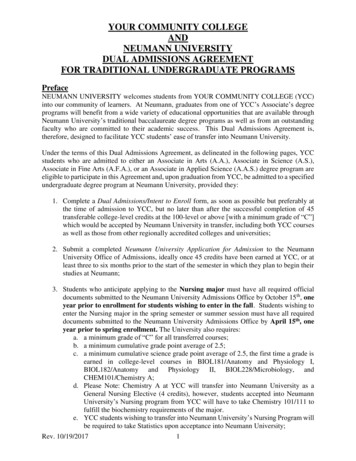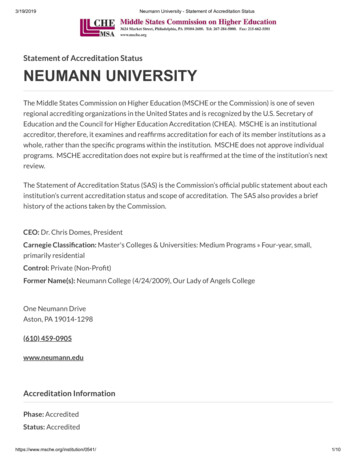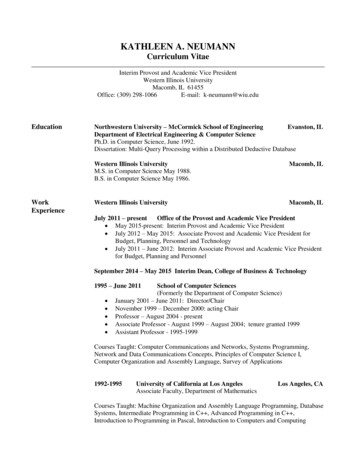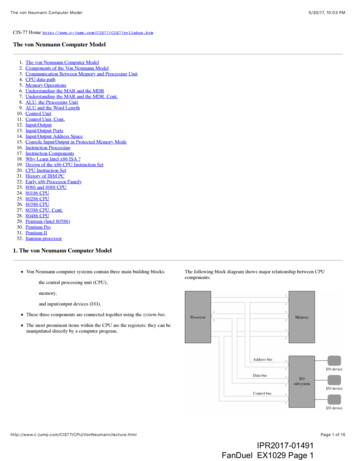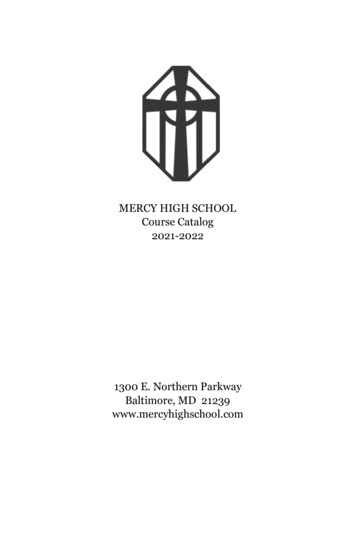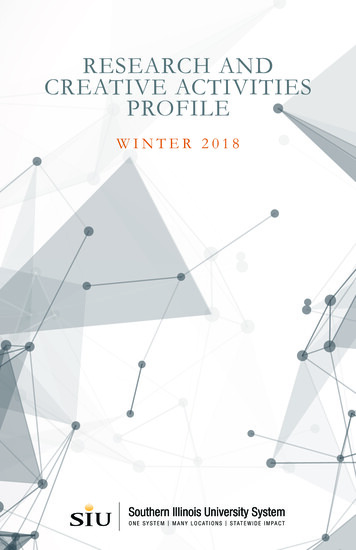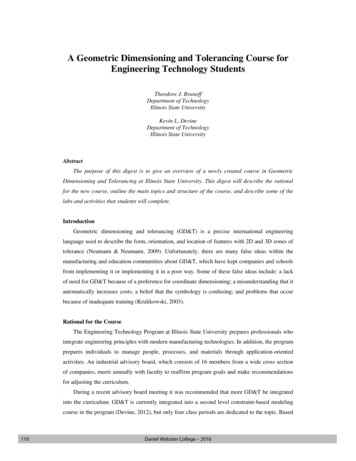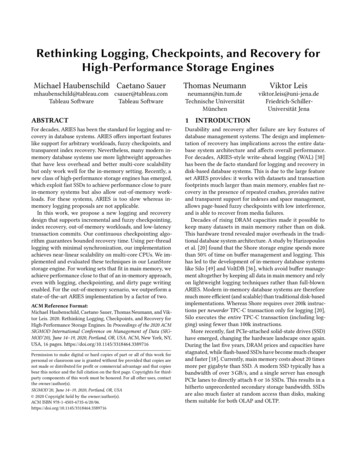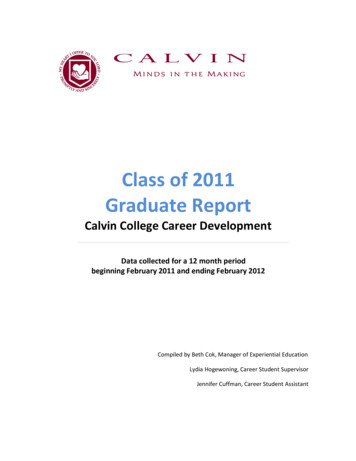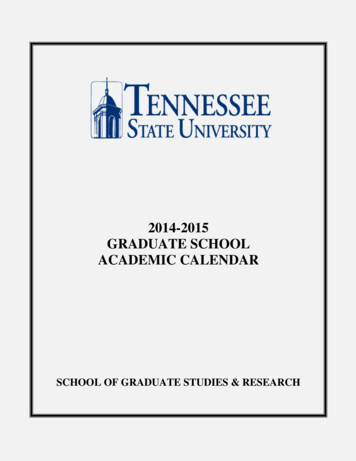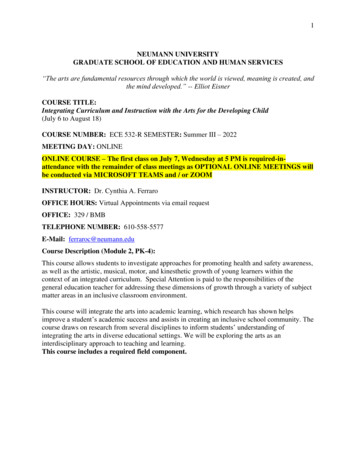
Transcription
1NEUMANN UNIVERSITYGRADUATE SCHOOL OF EDUCATION AND HUMAN SERVICES“The arts are fundamental resources through which the world is viewed, meaning is created, andthe mind developed.” -- Elliot EisnerCOURSE TITLE:Integrating Curriculum and Instruction with the Arts for the Developing Child(July 6 to August 18)COURSE NUMBER: ECE 532-R SEMESTER: Summer III – 2022MEETING DAY: ONLINEONLINE COURSE – The first class on July 7, Wednesday at 5 PM is required-inattendance with the remainder of class meetings as OPTIONAL ONLINE MEETINGS willbe conducted via MICROSOFT TEAMS and / or ZOOMINSTRUCTOR: Dr. Cynthia A. FerraroOFFICE HOURS: Virtual Appointments via email requestOFFICE: 329 / BMBTELEPHONE NUMBER: 610-558-5577E-Mail: ferraroc@neumann.eduCourse Description (Module 2, PK-4):This course allows students to investigate approaches for promoting health and safety awareness,as well as the artistic, musical, motor, and kinesthetic growth of young learners within thecontext of an integrated curriculum. Special Attention is paid to the responsibilities of thegeneral education teacher for addressing these dimensions of growth through a variety of subjectmatter areas in an inclusive classroom environment.This course will integrate the arts into academic learning, which research has shown helpsimprove a student’s academic success and assists in creating an inclusive school community. Thecourse draws on research from several disciplines to inform students’ understanding ofintegrating the arts in diverse educational settings. We will be exploring the arts as aninterdisciplinary approach to teaching and learning.This course includes a required field component.
2PECT/Course Objective/Assignment Alignment ChartCourse ObjectivePECTCompetenciesPDE CompetenciesRelated AssignmentStudents will evaluateeducational theory andpractice and issues suchas brain development, theimportance of play and avariety of curriculumapproaches in accordancewith PDESAS standardsPK-4Module 1, Subarea I:Child Development,Learning, andAssessment.I. Development,Cognition, and Language(A, B, C, D, E, F, H)ClassroomParticipation,Assigned Readings,and Knowledge-BaseDiscussionStudents will develop,implement, and discusscurriculum andlesson/unit plans tospecifically meet theneeds of diverse learners,including EnglishLanguage Learners.0001Understand thefoundation and principlesof child development andlearning.PK-4Module 1, Subarea I:Child Development,Learning, andAssessment.Reflection PaperFinal ExamI. Development,Cognition, and Language(C, F, H)0003Understandstrategies for meeting theneeds of EnglishLanguage Learners andstudents with disabilitiesin an inclusive PreK-4setting.PK-4Module 1, Subarea II:Collaboration andProfessionalism.0004 Understand familyand communityrelationships andcollaboration withfamilies, colleagues, andother professionals.Arts Integration andCurriculum Family(PK-4) Weebly andPresentationAssignmentsReflection PaperI. Development,Cognition, and Language(A, B, C, D, E, F, H)
3PECT/Course Objective/Assignment Alignment ChartCourse ObjectivePECTCompetenciesPDE CompetenciesRelated AssignmentStudents will demonstratethe ability to plan andimplementDevelopmentallyAppropriate Practice(DAP) lessons, whilemeeting standards.PK-4Module 1, Subarea I:Child Development,Learning, andAssessment.I. Development,Cognition, and Language(A, B, C, D, E, F, H)Arts Integration andCurriculum Family(PK-4) Weebly andPresentationAssignments0001Understand thefoundation and principlesof child development andlearning.PK-4Module 2, Subarea IISocial Studies, Arts, andHumanitiesField ExperienceII. Subject MatterPedagogy Content(F,G)0011 Understand thedevelopmentalfoundations of learning inarts and humanities;fundamental concepts andprocesses related to artsand humanities;assessment, instruction,and intervention forPreK-4 students in artsand humanities.Students will gainconfidence in developingintegrated lesson plansacross the fine arts.PK-4Module 2, Subarea II:Social Studies, Arts,Humanities.0011Understand thedevelopmentalfoundations of learning inarts & humanities;fundamental concepts andprocesses related to arts &humanities; &assessment, instruction, &intervention forPreK-4 students in arts &humanities.II. Subject MatterPedagogy Content(F,G)Arts Integration andCurriculum Family(PK-4) Weebly andPresentationAssignmentsField Experience
4PECT/Course Objective/Assignment Alignment ChartCourse ObjectivePECTCompetenciesPDE CompetenciesRelated AssignmentStudents will develop,implement, assess, andmodify curriculum andlessons for children fromPre-K through 4th gradeusing PA state standardsand National standards ifapplicable related tocreative arts, valuing theimportance of play,health, and wellness.PK-4Module 1, Subarea I:Child Development,Learning, andAssessment.I. Development,Cognition, and Language(A, B, D, E, F, H)Arts Integration andCurriculum Family(PK-4) Weebly andPresentationAssignmentsIII. Assessment(D,L)0002Understand varioustypes of assessment andevaluation and the use ofassessment to ensurechildren’s continuousdevelopment andachievement of definedstandards and goals.PK-4Module 2, Subarea II:Social Studies, Arts,Humanities.Field ExperienceII. Subject MatterPedagogy Content(F,G)0011Understand thedevelopmentalfoundations of learning inarts and humanities;fundamental concepts andprocesses related to artsand humanities; andassessment, instruction,and intervention for PreK4 students in arts andhumanities.PK-4Module 3, Subarea:Math, Science, Health0014Understand thedevelopmentalfoundations of learning inmotor development andhealth; fundamentalconcepts and processesrelated to motordevelopment and health;and assessment,instruction, andintervention for PreK-4students in motordevelopment and health.II. Subject MatterPedagogy Content(F,G)V. Professionalism(D, F, G, H, I, J, K)
5The student will acquire the following curricular skills:1. Align curricular goals and objectives that correspond with Early Childhood Education asper the National Association for the Education of young Children (NAEYC);2. Produce lesson plans using PA State Academic Achievement Standards, PA EarlyLearning Standards, PA Modified Academic Achievement Standards and StandardsAligned System;3. Relate educational theory and practice;The student will acquire the following dispositions:1. Apply personal knowledge to design, implement, and evaluate meaningful, challengingcurriculum that promotes comprehensive developmental and academic outcomes;2. Recognize appropriate accommodations and modifications for individual learners,including the use of assistive technology, materials adaptations, prompting strategies,environmental arrangements, and visual supports;3. Support the application of developmentally appropriate practice (DAP);4. Value physical activity for health, enjoyment, challenge, self-expression, and socialinteraction;5. Maintain a healthful environment;6. Understand what it means to be an “intentional teacher.”The student will acquire the following skills in creativity and the arts:1. Express proficiency with Pennsylvania’s early childhood learning standards for arts andhumanities including: production, performance, dance music, theater, and the visual arts;2. Create experiences that help children interact musically with others;3. Sing, play and produce music;4. Use music to express emotions, conflicts, and needs;5. Respond to expressive characteristics of music-rhythm, structures and informal musicplay;6. Move expressively to music of various tempos, meters, and modes to express what is feltand heard;7. Demonstrate knowledge and understanding of the national standards developed by theNational Association for Sport and Physical Education.8. Recognize attributes necessary to perform a variety of physical activities;9. Perform motor skills and movement patterns inherent to a variety of physical activities;10. Apply National Health Education Standards to the promotion of setting goals for goodhealth;11. Establish benchmarks for good health associated with nutritional well-being.
6ATTENDANCE AND PARTICIPATION:Class Meeting Time: Online/Asynchronous - students are expected to spend at least five to sixhours per week reading and reviewing course materials and completing assignments.This course is made up of a series of assignments and assessments to assist you in achieving thecourse and module learning objectives. Each week you will work on various combinations ofassignments, activities, discussions, readings, research, and projects.STUDENT DISABILITY POLICY:Students requiring accommodations for a physical or diagnosed learning disability shouldcontact the instructor and the Learning Assistance Center and refer to the Students withDisabilities section of the Neumann University Catalog for procedures.ACADEMIC POLICIES:Please note that students in this class should follow all University policies pertaining to academichonesty. Consult the Neumann University Catalog or ask me if you have any questions aboutany relevant academic policy.AB BC CD DF93-100%89-92%85-88%81-84%77-80%74-76%73-70%Below 70Technology and Technical Skills Requirements Internet connection (DSL, LAN, or cable connection desirable) Access to Blackboard LearnPlease use the Quick reference guide to NU Learn to help you with technology issues and gettingacclimated withBlackboard ents 12.pdfThis course requires you to use online library resources, produce an annotated bibliography inWord with appropriate references according to APA style, and to navigate the online course inNU Learn (Blackboard Learn).All email communication should be conducted using the NU email address given to you atadmission. Your Neumann email prefix and password are used to log in to Neumann based sites,including, but not limited to email, NU Learn, SharePoint, One Drive, Web Advisor, etc.
7Grading PolicyCOURSE GRADING (Based on a total of 550 points)AB BC CD DF 3.76 - 4.003.50 - 3.753.00 - 3.492.50 - 2.992.00 - 2.491.50 - 1.991.00 - 1.490.00 - 0.99 93 - 100%89 - 92%85 - 88%81 - 84%77 - 80%74 - 76%73 - 70%Below 70Grades with Quality PointsThe following grading system, with stipulated numeric and quality point equivalencies, has beenestablished for any student enrolled in one of the following Neumann University graduateprograms: Accounting, Education, Nursing, Pastoral Care and Counseling, Sport andEntertainment Management, and Strategic Leadership. This grading scale is utilized by allgraduate faculty who teach in one of these programs.A (93-100)B (89-92)B (85-88)C (81-84)C (77-80)F (below 77)carries 4 quality pointscarries 3.5 quality pointscarries 3 quality pointscarries 2.5 quality pointscarries 2 quality pointscarries 0 quality pointsLearner SupportThere are many supports available to you at Neumann, so please review the links below forspecific areas of support and contact me with questions:Computer Facilities and Media Supporthttp://www.neumann.edu/life/ITR toid 9&navoid 256#Computer Facilities and Media ServicesNU Learn (BlackBoard) SupportLog onto NU Learn through the drop down login menu on the NU webpage www.neumann.eduSupport for NU Learn is on the opening page http://www.neumann.edu/academics/online.aspADA Compliance and lities.asp
8The HUB at NU – The John C. Ford Student Success Center at Neumann The Writing Center provides a space for all writers to improve their craft in a friendly and supportiveenvironment. Located on the ground floor of Bachmann, in the HUB at NU, the Center is staffed bytrained tutors that can assist students through all stages of the writing process, from brainstorming tofinalizing a draft. Tutors act not as editors or co-authors, but as critical readers and guides to help youimprove your writing skills.To schedule an appointment, visit mywco.com/neumann. If you are a first-time user, you will need toregister for an account. If you have questions, please contact writingcenter@neumann.edu.Academic Life fault.aspStudent Life Services - http://www.neumann.edu/life/default.aspStudent Affairs .php?catoid 10&navoid 295ASSIGNMENTSTextbook:Zhou, Molly & Brown, David (May 2018). Arts Integration in Elementary Curriculum, 2ndEdition. Galileo: Georgia’s Virtual .cgi?article 1002&context education-textbooksSelected Articles:Association for Curriculum and Development (ASCD)ASSESSMENT AND LEARNING ACTIVITIES:The instructor will have all assignments graded and returned to students within a week’s time ofdue date. All assignments are due to the instructor on the due date assigned. Late assignmentswill automatically receive a deduction of one letter grade for each day late. Plan ahead,technology problems, etc. are not an acceptable excuse. Please plan accordingly.Classroom Participation, Assigned Readings, and Knowledge-Base Discussion: 10%Sharing the widely varying experiences of class members will enhance learning and thinkingabout educational research. It is important that everyone be prepared to participate indiscussions and offer their knowledge-based contributions. In this regard, it is imperative thatviews of others be given respect and professional courtesy. Class participation includesparticipation in class discussions.Weekly Assignments: 20%Assignments will be discussed in class and disseminated to students well in advance to theassignment due date.
9Culminating Final Arts Integration and Curriculum Family Assignment (PK-4): 50%Students will create a website (using the free or paid version of Weebly – your choice) thatincludes the following resources related to integrating the arts as per varied curricula andproviding families with resources (SEE RUBRIC ON PAGE 15 WITHIN SYLLABUS ANDSTUDENT SAMPLES EMBEDDED INTO THE RUBRIC)A) Create a children’s literature list in the following categories: drama, visual arts, music, andhealth and gross motor/movement. Each category should include 5 books and grade levels (a totalof 20 books). Underneath each book provide an annotation that describes the story, as well as anexplanation on how to utilize the book related to the various categories (30 points).Suggested Children’s Literature s/2966B) Locate and post a collection of 10 videos demonstrating creative arts lesson plans completedwith young children. Under each video link, add an annotation explaining the connections to thestandards (Common Core State Standards or PA Academic Standards), accommodations, anddifferentiation ideas (30 points).C) Create a resource for families to include 20 ways to integrate the arts, including activities,books, and resources that families can use with children to integrate the arts during the summer –provide an annotation that describes each resource (30 points).D) On the due date of Friday, August 12, you are required to provide the Weebly website via theBlog Assignment section within Blackboard Learn (10 points).Reflection Paper or Field Experience: 10%Reflection papers serve several purposes.1. The process of putting thoughts on paper proved to be a meaningful learning experience.2. Reflection papers demonstrate not only that you are reading the material, but also thatyou are pondering the issues.3. Reflection papers allow you to articulate ideas and arguments while you are reading andthus be better prepared to participate in discussion during the next class.4. Reflection papers provide a mechanism to explore ideas that are not necessarily coveredin class or that you may be hesitant to assert verbally. They allow you to apply what youare learning to your personal life experiences.5. Reflection papers develop complex insights and theories and allow you to speculate aboutthe future. Most significantly, reflection papers allow you to be engaged in the process of
10experiencing the harmony or dissonance between the perspectives described in thereadings and your own.6. Reflection paper will be due on August 12, 2022, and should be part of theculminating Weebly assignment.Reflection Paper Format:Part I: Your ThesisIn ONE paragraph, respond to the following question:How important is it for young learners to be engaged in a curriculum that is integratedthroughout it with experiences from the arts?Part II: Your AnalysisIn TWO paragraphs, explain how continuity and change are evident in an artsintegrated curriculum.In ONE paragraph, describe one idea that the textbook provides for planning andassessing a unit on just one skill subject or integrated skill subjects for young learners inan arts-integrated curriculum.Part III: Your SynthesisIn ONE paragraph, summarize your 3 prior reflections by pointing out what youranalysis will do to promote academic achievement.Part IV: Works Cited PageAll resources (at least 3-5 outside resources that includes your textbook) used in thedevelopment of your reflection paper must be included in a formal reference list. UseAPA format.The following APA web links will provide guidance when creating a “Works Cited”page, as well as offer varied tips when writing a paper using the APA format: APADocumentation, APA Research Style Crib Sheet, APA Style Tips
11PLEASE FOLLOW THE FORMAT/RUBRIC BELOW:STRUCTURE AND RUBRIC FOR PREPARATION AND EVALUATION OFREFLECTION PAPERPart I: Thesis1. CONTEXT: The thesis statement is a paragraph that takes a position about the assignedtopic. It is an introduction to an analysis of the position being taken later on in the paper.2. QUANTITY: One paragraph in length.Part II: Analysis1. CONTEXT: Analysis is the heart and soul of the reflection paper. It consists of a seriesof paragraphs that provide documented support in defense of the thesis statement (Part I).Documented support means making accurate references to authorities and experts whoback up your position. A single reference (see below under “quantity”) may be as shortas one sentence or as long as one paragraph. References can be direct quotations,paraphrases, or combinations of both.2. QUANTITY: Analysis sections of reflection papers should contain at least threeparagraphs.Part III: Synthesis1. CONTEXT: Synthesis is where you tie together the first two parts of the paper. First,the synthesis sums up what the meaning of all of the references in the Analysis section isto you. For example, it can use expressions such as “ the experts agree ” or “ theinformation suggests ” This summing up is followed by a conclusion based upon howthese authoritative sources support your thesis.2. QUANTITY: One paragraph in length.Part IV: Works Cited Page#REFLECTION PAPERELEMENTS1Thesis statement:1.Context2. QuantityAnalysis:1. Context2. QuantitySynthesis:1. Context2. QuantityWorks Cited3-5 Sources APA Format234INCOMPLETE( 0 points)COMPLETE(15 points)COMPLETE ANDACCURATE(22 points)COMPLETE,ACCURATE, ANDPRECISE(25) points)
12Field Experience or Reflection Paper: 10%Students will spend 5-10 hours observing a child, classroom of children, or a group of childrenengaged in a creative activity. Students will also spend time engaging with a child, classroom ofchildren, or a group of children in a creative activity designed by the graduate student. Any childcan be used for this activity. A full 2-page report of the designed activity and observations mustbe submitted as part of the culminating Weebly assignment that is due on August 12, 2022.Field Experience will be no less than 2-pages and not more than 4-pages in length- due onAugust 12, 2022 and should be part of the culminating Weebly assignment.Final Exam: 10%Submission, review, and evaluation of Weebly Sites on NU’s Blackboard Learn and as discussedin class. Post your Weebly domain address as your initial blog with a brief overview of your site.Examine all Weebly sites created by class members and then post a Weebly-review-blog for atleast three sites and no more than five sites (no more than a paragraph for each Weebly review).Due by Friday, August 12, 2022, as Part II of your final exam.
13CONTENT OUTLINE-SYLLABUS IS SUBJECT TO CHANGEPLEASE TURN OFF ALL CELL PHONES DURING CLASS, IN THE EVENT OF ANEMERGENCY; PLEASE SEE THE INSTRUCTOR – THANK YOU!Students are expected to read assigned materials prior to class meetings to assure interactivediscussion and presentations.July 7, Thursday-Required in Attendance-Introduction to course expectations, textbook website, BlackboardLearn navigation, and Weebly-Why is the Integration of the Arts into Required CurriculumRelevant? – Smarty Pants? Icebreakers Assignments for Next Week (due before or on July 13) – Module 1– Character EducationJuly 13-Assignments for Next Week (due before or on July 20) – Module2 – Metacognition Logs, Chapters 3,4,5 – Required to use theMetacognition Log template that is found on page 24 withinsyllabus – submit 3 Metacognition Logs – one for each chapter.- Culminating Weebly Website- Arts Integration and CurriculumFamily (PK-4) - due Friday, August 12-submit on BlackboardLearn as indicated within the Blog Assignment directionsJuly 20- Centers for The Arts and the relevance of cooperative learningand The Arts-Assignments for Next Week (due before or on July 27) – Module3.- Culminating Weebly Website- Arts Integration and CurriculumFamily (PK-4) - due Friday, August 12-submit on BlackboardLearn as indicated within the Blog Assignment directionsJuly 27-Visual Arts, Creative Drama, and Creative Games/Children’sGames-Assignments for Next Week (due before or on August 3) –Module 4- Culminating Weebly Website- Arts Integration and CurriculumFamily (PK-4) - due Friday, August 12-submit on BlackboardLearn as indicated within the Blog Assignment directionsAugust 3-Assignments for Next Week (due before or on August 10) –Module 2 – Metacognition Logs, Chapters 6,7 – Required to usethe Metacognition Log template that is found on page 24 withinsyllabus – submit 3 Metacognition Logs – one for each chapter.- Culminating Weebly Website- Arts Integration and CurriculumFamily (PK-4) - due Friday, August 12-submit on BlackboardLearn as indicated within the Blog Assignment directions
14August 10- Culminating Weebly Website- Arts Integration and CurriculumFamily (PK-4) - due Friday, August 12-submit on BlackboardLearn as indicated within the Blog Assignment directionsAugust 12Submission, review, and evaluation of Weebly Sites on NU’sBlackboard Learn and as discussed in class – due no later thanFriday, August 12. Post your Weebly domain address as yourinitial blog with a brief overview of your site. Examine all Weeblysites created by class members and then post a Weebly-reviewblog for at least three sites and no more than five sites (no morethan a paragraph for each Weebly review).August 18Closing and Final Assessment – Weebly Review of Sites
15RUBRIC: Holistic Impact of Weebly site:My Sample:https://artsyferraro.weebly.comStudent eaches.weebly.com/videos.html25 pts.Knocks me off my feet, so informative, and evidence of original thinking.Includes excellent writing, creativity, and amazing visuals. Research is interesting, surprising,and deftly and creatively incorporated throughout site. Clever title with website submitted on theassigned due date.10-15 pts. An excellent, fulfilling Weebly site.0 pts.An insult to turn in.Children’s Literature:25 pts.Perfect – all 20 sources and annotations are listed with meaningful information– and corresponding visuals.10 pts.0-5 pts.Missing annotations and book criteria.Missing altogether, missing books, or little effort into annotations.Videos:25 pts.Perfect – all 10 videos and annotations are listed with meaningful informationand corresponding visuals.10 pts.0-5 pts.Missing videos and video annotations.Missing altogether, missing videos, or little effort into annotations.Twenty Resources:25 pts.Perfect – all 20 resources and annotations are listed with meaningfulinformation and corresponding visuals.10 pts.Missing videos and video annotations.0-5 pts.Missing altogether, missing videos, or little effort into annotations.
16Course URSE:TOTALSTUDENTSDEPARTMENT: :DATEPA State StandardsReferenced from http://www.pdesas.org/ orhttp://www.pakeys.org/pages/get.aspx?page EarlyLearningPA STATE APPROVED ACADEMIC STANDARDS – 3-5 ACADEMIC STANDARDS3-5 BEHAVIORAL OBJECTIVES THAT CORRESPOND WITH PA STATE ACADEMIC STANDARDSAS LISTED ABOVELesson Introduction: (5-7 min)
17Activities/Procedures: (25-30min)Lesson Plans are conducive to student achievement and focus on PA State standardsand objectiveClosing& Assessment: (5-7 min)SPECIFICALLY IDENTIFY ASSESSMENTS AS PER CONNECTIONS TO THE PA STATE STANDARDSAND LESSON BEHAVIORAL OBJECTIVES – IN OTHER WORDS, HOW WILL THESTANDARDS/OBJECTIVES BE ACCOMPLISHED THROUGHOUT THIS LESSON
18Assessment Procedures: (check all that apply)FormativeGuided PracticeParticipationEnrichmentPSSA Type QuestionsHomeworkNotebook CheckGroup WorkRubricIndependentPracticeAuthentic SA Type QuestionsNotebook CheckAuthentic AssessmentOther:Structure should simulate PSSA testing format to assist with PSSA test prepMaterials/ResourcesText Book:Graphic Organizer/Handouts(s):Technology:Other:List of resources used and incorporated into activity and assessments, attach anyteacher made materials and/or worksheetsAccommodations
19Differentiated InstructionNotes for the Substitute
20In accordance with Neumann University educational guidelines for emergent teachers pleasedescribe how the following INTASC Principles were reflected in your lesson plan and thedelivery of the lesson.INTASC PrinciplesInterstate New Teachers Assessment and Support ConsortiumINTASC 1: Making content meaningful The teacher understands the central concepts, tools of inquiry, and structures of the discipline(s)he or she teaches and creates learning experiences that make these aspects of subject mattermeaningful for students.Evidence/Reflection:INTASC 2: Child development and learning theory The teacher understands how children learn and develop and can provide learning opportunitiesthat support their intellectual, social, and personal development.Evidence/Reflection:INTASC 3: Learning styles/diversity The teacher understands how students differ in their approaches to learning and createsinstructional opportunities that are adapted to diverse learners.Evidence/Reflection:INTASC 4: Instructional strategies/problem solving The teacher understands and uses a variety of instructional strategies to encourage students’development of critical thinking, problem solving, and performance skills.Evidence/Reflection:INTASC 5: Motivation and behavior The teacher uses an understanding individual and group motivation and behavior to create alearning environment that encourages positive social interaction, active engagements in learning,and self-motivation.Evidence/Reflection:
21INTASC 6: Communication/knowledge The teacher uses knowledge of effective verbal, nonverbal and media communication techniquesto foster active inquiry, collaboration, and supportive interaction in the classroom.Evidence/Reflection:INTASC 7: Planning for instruction The teacher plans instruction based upon knowledge of subject matter, students, the community,and curriculum goals.Evidence/Reflection:INTASC 8: Assessment The teacher understands and uses formal and informal assessment strategies to evaluate andensure the continuous intellectual, social, and physical development of the learner.Evidence/Reflection:INTASC 9: Professional growth/reflection The teacher is a reflective practitioner who continually evaluates the effects of his or her choicesand actions on others (students, parents, and other professionals in the learning community) andwho actively seeks out opportunities to grow professionally.Evidence/Reflection:INTASC 10: Interpersonal relationships The teacher fosters relationships with school colleagues, parents, and agencies in the largercommunity to support students’ learning and well-being.Evidence/Reflection:
22Neumann UniversityLesson Plan FormatSubjectGradeUnit TitleLessonEstimated Time PeriodI.Learning Objective(s) (2-3) original group objectives – cognitive domainhttp://cstep.csumb.edu/Obj tutorial/bloomwheel.html II.What will students know, understand, and be able to do by the end of this lesson?An original objective – cognitive domainAn original objective – affective domainAn original objective – psychomotor domainState Standards and/or INTASC StandardsPennsylvania Department of Education Academic Standards (2-4 Standards presented intheir entirety).http://www.pdesas.org/ and/or the standards for the National Association for the Educationof young Children (NAEYC):http://en.wikipedia.org/wiki/National Association for the Education of Young Pbl/The%20INTASC%20Standards%20overheads.htmThe Performance-Based Licensure product uses the ten standards articulated by theInterstate New Teacher Assessment and Support Consortium (INTASC). Thesestandards reflect the professional consensus of what beginning teachers should know andbe able to do. The standards and the key indicators assoc
E-Mail: ferraroc@neumann.edu Course Description (Module 2, PK-4): This course allows students to investigate approaches for promoting health and safety awareness, as well as the artistic, musical, motor, and kinesthetic growth of young learners within the context of an integrated curriculum. Special Attention is paid to the responsibilities of the
